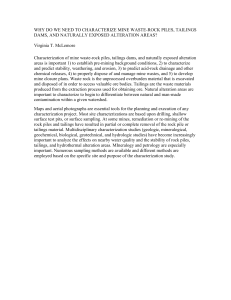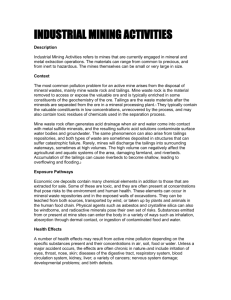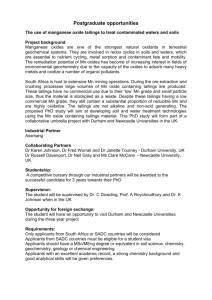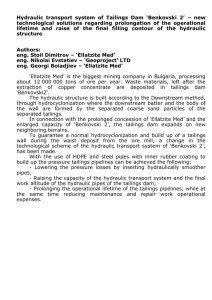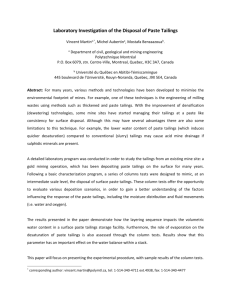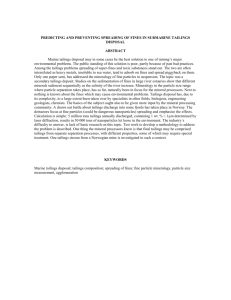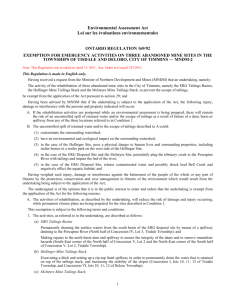Mine Tailings and Saltbush Revegetating the dusty leftovers from
advertisement
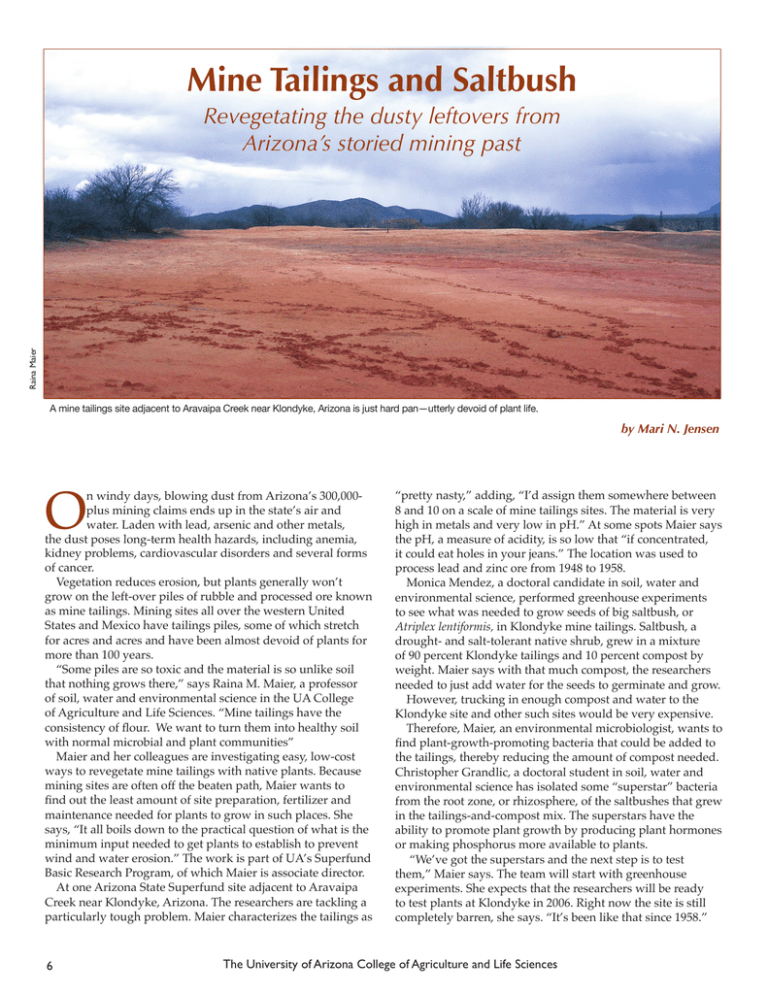
Mine Tailings and Saltbush Raina Maier Revegetating the dusty leftovers from Arizona’s storied mining past A mine tailings site adjacent to Aravaipa Creek near Klondyke, Arizona is just hard pan—utterly devoid of plant life. by Mari N. Jensen O n windy days, blowing dust from Arizona’s 300,000plus mining claims ends up in the state’s air and water. Laden with lead, arsenic and other metals, the dust poses long-term health hazards, including anemia, kidney problems, cardiovascular disorders and several forms of cancer. Vegetation reduces erosion, but plants generally won’t grow on the left-over piles of rubble and processed ore known as mine tailings. Mining sites all over the western United States and Mexico have tailings piles, some of which stretch for acres and acres and have been almost devoid of plants for more than 100 years. “Some piles are so toxic and the material is so unlike soil that nothing grows there,” says Raina M. Maier, a professor of soil, water and environmental science in the UA College of Agriculture and Life Sciences. “Mine tailings have the consistency of flour. We want to turn them into healthy soil with normal microbial and plant communities” Maier and her colleagues are investigating easy, low-cost ways to revegetate mine tailings with native plants. Because mining sites are often off the beaten path, Maier wants to find out the least amount of site preparation, fertilizer and maintenance needed for plants to grow in such places. She says, “It all boils down to the practical question of what is the minimum input needed to get plants to establish to prevent wind and water erosion.” The work is part of UA’s Superfund Basic Research Program, of which Maier is associate director. At one Arizona State Superfund site adjacent to Aravaipa Creek near Klondyke, Arizona. The researchers are tackling a particularly tough problem. Maier characterizes the tailings as 6 “pretty nasty,” adding, “I’d assign them somewhere between 8 and 10 on a scale of mine tailings sites. The material is very high in metals and very low in pH.” At some spots Maier says the pH, a measure of acidity, is so low that “if concentrated, it could eat holes in your jeans.” The location was used to process lead and zinc ore from 1948 to 1958. Monica Mendez, a doctoral candidate in soil, water and environmental science, performed greenhouse experiments to see what was needed to grow seeds of big saltbush, or Atriplex lentiformis, in Klondyke mine tailings. Saltbush, a drought- and salt-tolerant native shrub, grew in a mixture of 90 percent Klondyke tailings and 10 percent compost by weight. Maier says with that much compost, the researchers needed to just add water for the seeds to germinate and grow. However, trucking in enough compost and water to the Klondyke site and other such sites would be very expensive. Therefore, Maier, an environmental microbiologist, wants to find plant-growth-promoting bacteria that could be added to the tailings, thereby reducing the amount of compost needed. Christopher Grandlic, a doctoral student in soil, water and environmental science has isolated some “superstar” bacteria from the root zone, or rhizosphere, of the saltbushes that grew in the tailings-and-compost mix. The superstars have the ability to promote plant growth by producing plant hormones or making phosphorus more available to plants. “We’ve got the superstars and the next step is to test them,” Maier says. The team will start with greenhouse experiments. She expects that the researchers will be ready to test plants at Klondyke in 2006. Right now the site is still completely barren, she says. “It’s been like that since 1958.” The University of Arizona College of Agriculture and Life Sciences Raina Maier Water erosion of mine tailings into the San Pedro River in southeastern Arizona Maier’s team has successfully planted a different species of saltbush, four-wing saltbush, on mine tailings at an older site by the San Pedro River. She says, “The site is a different challenge, because it’s highly toxic with regard to metals but is a relatively neutral pH.” The 100-acre site, known as Boston Mill, was used from 1879 to 1887 to process silver and gold ore brought from Tombstone, Arizona, Maier said. Plants have begun to naturally encroach onto the site, but the progression is slow. The center of the site is still barren. communities surrounding the roots of the saltbushes. Initially there was no difference between the plants’ rhizosphere and a nearby part of the tailings without plants — both samples had lower numbers of microbes than does normal soil. However, soon the microbial communities around the plants began to flourish, ultimately developing the same numbers of microbes as normal soil — 50 to 100 times as many as in the unplanted area of the tailings. “It was an exciting result,” microbiologist Maier says. “Microorganisms are essential components of functioning soil ecosystems.” Maier’s work suggests that some mine tailings can be easily revegetated. “We can actually write some guidelines,” she says. “If you have a site we’re calling moderately impacted — you do have high metals, but pH is not an issue — probably you can go in and revegetate with pretty minimal inputs. You don’t seem to need compost. You do need to establish with water for a period of time.” In the spring of 2006, the team will tackle the extremely acidic Klondyke site. The researchers will plant saltbushes using various combinations of compost and microbes with the aim of developing some general guidelines for revegetating such tough sites. Maier’s ultimate goal is for people to revegetate mine tailings just using seeds and a squirt bottle full of soil microorganisms. “Microbes can make plant hormones, bind toxic metal and help condition sites,” she says. “My hope and dream is that we would be able to soak seeds in a microbial inoculum, then plant them and walk away.” Researchers grew four-wing saltbush, Atriplex canescens, in the greenhouse and Karyna Rosario, a master’s student in soil, water and environmental science, transplanted twomonth-old plants onto the tailings in October 2003. Some plants were planted in a tailings-and-compost mix, other went straight into tailings. Initially the plants were watered, but the researchers tapered off on watering and let the summer monsoons take over in 2004. The plants survived and became established whether or not they were in compost-enriched tailings. However, the plants seemed to stop growing between year one and two. One problem might have been that the monsoon rains were sparse during the summer of 2004. “After the first year the plants just didn’t grow any further. Is this the point where metal toxicity takes over, or did they simply not have enough water? We still have to answer that question.” She added, “Most researchers don’t do long-term experiments and so don’t see effects like this. It’s our goal to run multiple-year field trials to test this technology.” To see whether the soil microorganisms changed during the experiment, the researchers sampled the microbial Raina Maier “Mine tailings have the consistency of flour. We want to turn them into healthy soil with normal microbial and plant communities.” Graduate student Karyna Rosario takes measurements in the field during the San Pedro revegetation experiment. CONTACT Raina M. Maier 520-621-7231 rmaier@ag.arizona.edu University of Arizona Superfund Basic Research Program superfund.pharmacy.arizona.edu/research%202005/proj10. html 2005 Agricultural Experiment Station Research Report 7

